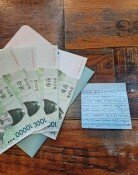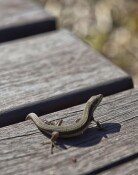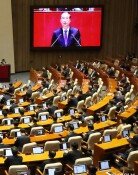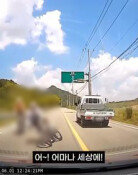Rhee Syng-man and Yo Un-hyung
Rhee Syng-man and Yo Un-hyung
Posted July. 19, 2017 07:25,
Updated July. 19, 2017 07:33
The Hanmin Party and the Communist Party were in the fiercest confrontation and even labeled each other traitors of the Korean people amid chaotic political situation after the nation’s liberation. If we were to place the political forces of the period soon after the liberation on a single spectrum, the Hanmin Party, Rhee Syng-man and Kim Gu would be seen as rightists, and Kim Gyu-shik and Ahn Jae-hong as central rightists, while Yo Un-hyung would be deemed as a central leftist, and Park Heon-yeong and Kim Il-sung leftists.
Park Heon-yeong and Kim Il-sung were both communist party members and strong rivals each other. Originally, the Communist Party in Seoul, which was controlled by Park Heon-yeong, was the party headquarters, and the group controlled by Kim Il-sung was the North Korean branch under the party. After seizing control of the North Korean branch, Kim Il-sung established a Unification Front Organization with other political forces and named it "ad hoc people’s committee." However, the Unification Front in South Korea received support for collaboration between the rightists and leftists from the U.S. military government office. Against this backdrop, Yo Un-hyung of the People’s Party was inevitably in the spotlight, and Park Heon-yeong feared his possible isolation. Kim Il-sung preferred Yeo who supports collaboration between the rightists and leftists. Later on, Park Heon-yeong was purged and Yo Un-hyung’s children received recognition and generous treatment in North Korea.
Rhee Syng-man returned to Korea from the U.S. belatedly and established the Central Council for Independence Promotion to secure independence from the Hanmin Party, and started mobilizing his own force. Rhee was more negative about collaboration between the rightists and leftists than any others, and was confronting John Hodge of the U.S. military government office, who supported collaboration between the rightists and leftists by taking advantage of centralists including Yo Un-hyung and Kim Gyu-shik. The U.S. military government’s support of collaboration between the rightists and leftists disappeared in 1947 when the Cold War started in earnest after the Truman Doctrine was announced in the wake of threat for Greece’s communization.
Amid the chaotic political situation following Korea’s liberation, Song Jin-woo, Yo Un-hyung and Kim Gu were assassinated in succession. Bruce Comings believes that the assassination of Song Ji-woo, a strategist of the Hanmin Party, was committed by Kim Gu’s group. Some believed that Yo Un-hyung was assassinated by the rightist group, while others say it was committed by Park Heon-yeong’s group. A theory suggested that Kim Gu was assassinated by Rhee Syng-man’s group. Today marks 70 years that Yo Un-hyung was attacked during daytime at Hyehwa-dong Rotary in Seoul. Rhee, the first president of South Korea’s independent government, died in loneness 52 years ago today while in political exile in Hawaii after being ousted for dictatorial rule. We can almost feel the fierceness of the time even today.







